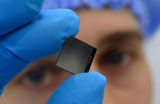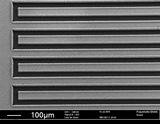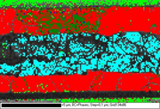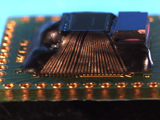Tokyo, Japan - Tokyo Big Sight - / January 27, 2016 - January 29, 2016
nano tech 2016
International Nanotechnology Exhibition & Conference
hall 5, booth 5J-14
International Nanotechnology Exhibition & Conference
hall 5, booth 5J-14
Fraunhofer ENAS shows samples of nanomaterials in application together wir the Fraunhofer Project Center “NEMS/MEMS Devices and Manufacturing Technologies at Tohoku University” and the Gessner Group of WPI-AIMR, Tohoku University at the nano tech 2016 on Germany Pavilion in hall 5, booth 5J-14.
Exhibits:
MEMS loudspeaker utilizing metallic glass membrane and deposited magnet

The silicon-based MEMS loudspeaker consists of a metallic glass membrane with dispensed magnetic paste and electroplated micro coil. This is the world’s first approach of a MEMS speaker with electrodynamic actuation that is completely fabricated on wafer-level with no need to attach bulk magnets manually. Metallic glasses exhibit high strength, large elastic limit and no material fatigue.
Mirau interferometer for vertically integrated array-type Mirau-based OCT system for early diagnostics of skin pathologies

The Mirau interferometer, consists of a doublet of array of micro lenses, an array of actuated micro mirror, a focus-adjustment spacer and a beam splitter plate. The batch fabrication can be achieved through optimized MOEMS process which gathers similar components onto specialized wafers such as Si or glass. The 5-stack demonstrator is anodic bonded at bonding temperature lower than 360 °C.
Nanoporous metal for micro energy storage systems

For achieving high values of electrical capacitance in supercapacitor architectures, electrodes with large surface-to-volume ratio are needed. Fraunhofer ENAS is applying nanoporous metal within a simple and MEMS compatible process. Fabricated nanoporous gold structures can be applied as electrodes for micro double-layer capacitors (supercapacitors).
Solid-liquid interdiffusion bonding (SLID) at wafer-level

SLID bonding is realized by a short liquid phase of one low melting metal and the immediate solidification caused by diffusion and intermixing with a second, high melting metal (Solid-Liquid Interdiffusion – SLID). Ideally a stable intermetallic phase is generated. Depending on the low melting material some of the combinations allow a process temperature lower than 300 °C.
Aerosol jet printing

Aerosol Jet is a non-contact direct-writing technology which allows the deposition of various functional materials such as particle inks, polymers, etchants and paste like fluids. By combination of both pneumatic atomizers, mixing of different materials becomes possible. With this unique mixing process, i.e. graded depositions of functional layers can lead to new applications.
Presentations:
Wed, January 27, 2016 - 11:00-11:20
"Coating, encapsulation, and packaging technologies for
smart integrated systems"
Dr. Mario Baum (Fraunhofer ENAS)
Session: Welcome to Nanotech Germany - Nano in Saxony "Organic Electronics and Nano Materials for Energy and Mobility", Part 1
German Pavilion hall 5 - Saxony Pavilion
Thu, January 28, 2016 - 11:05-11:25
"Internet of Things – Trends and Tendencies"
Prof. Dr. Thomas Gessner (Director, Fraunhofer ENAS)
Session: Welcome to Nanotech Germany - Nano in Saxony "Organic Electronics and Nano Materials for Energy and Mobility", Part 2
German Pavilion hall 5 - Saxony Pavilion
Thu, January 28, 2016 - 12:25-12:45
"Thermoelectric performance of thin films material"
Dr. Mai Phuong Nguyen (WPI-AIMR, Tohoku University / Fraunhofer Project Center for MEMS/NEMS devices)
Session: Welcome to Nanotech Germany - Nano in Saxony "Organic Electronics and Nano Materials for Energy and Mobility", Part 2
German Pavilion hall 5 - Saxony Pavilion
Fri, January 29, 2016 - 14:30-14:50
"Innovative Smart Systems and Technologies"
Assoc. Prof. Dr. Jörg Frömel (Fraunhofer Project Center for MEMS/NEMS devices / WPI-AIMR, Tohoku University)
Session: Welcome to Nanotech Germany - Nano in Saxony "Organic Electronics and Nano Materials for Energy and Mobility", Part 5
German Pavilion hall 5 - Saxony Pavilion